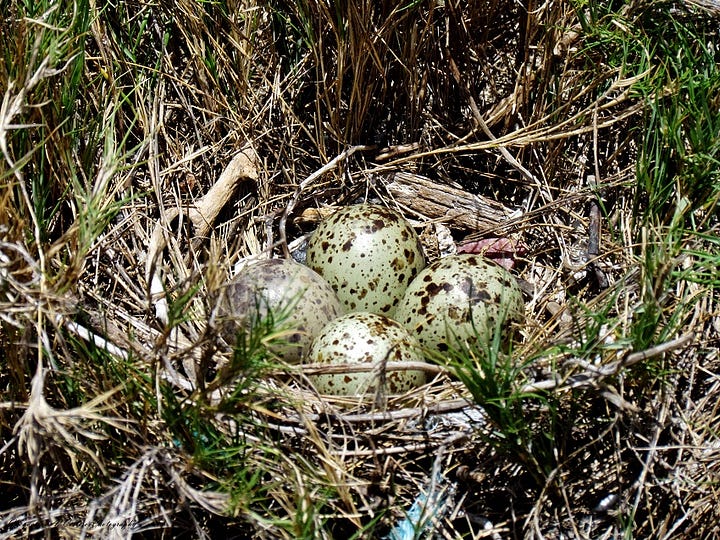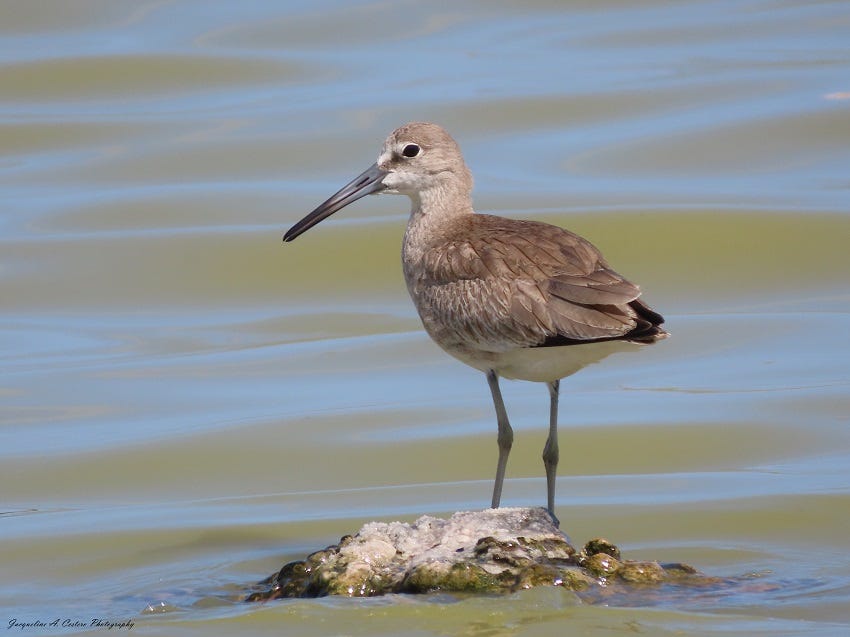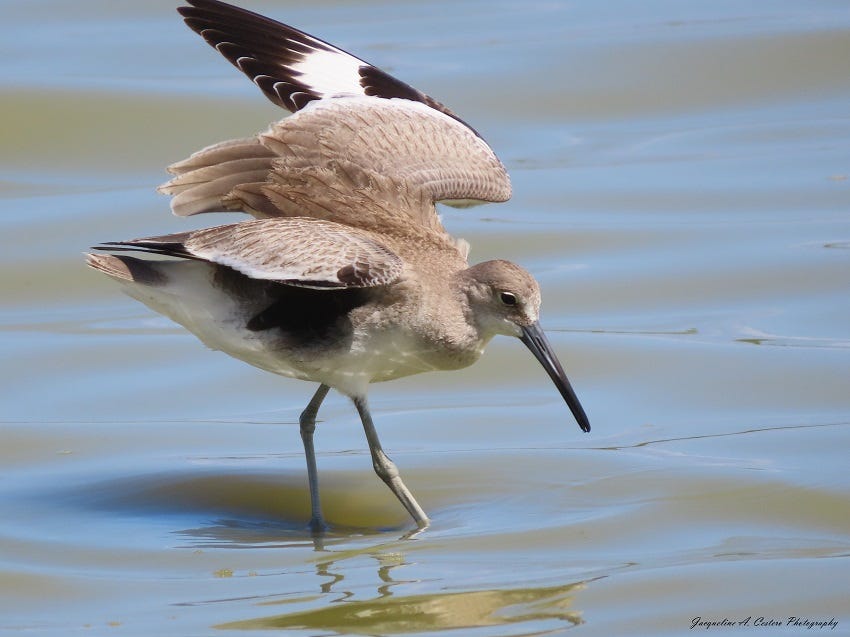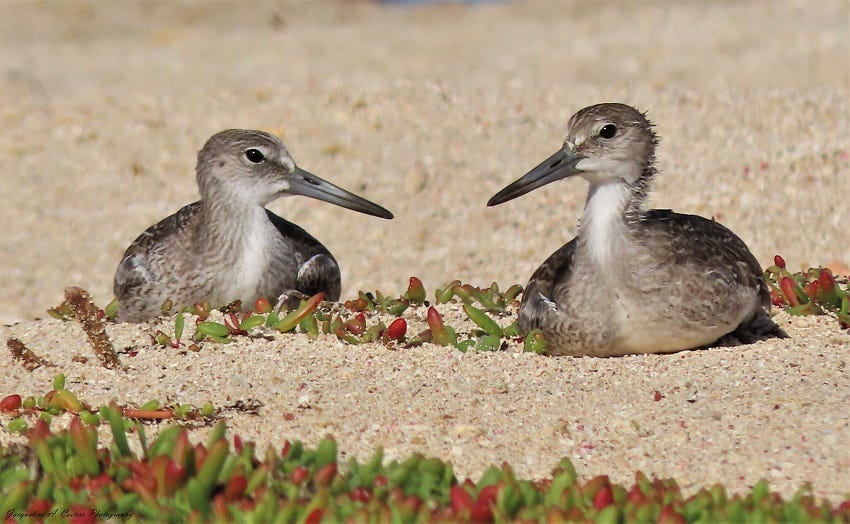The Summer nesting season would not be complete without the presence of our visiting Willets.
This species arrives each Spring from its non-breeding territory in the southern USA or South America specifically to breed on our wetlands. Favoring coastal habitats (especially those with telephone poles for perching), their arrival is marked by a ruckus call that sounds like “pill-will-willet.”
This brown shorebird of the Tringa family is one inch larger than a Greater Yellowlegs at 15 inches with a thick dark bill and gray legs.
They are unremarkable until they take flight and display a stunning black and white wing pattern.
Birds of the World describes the two populations that comprise this species as follows:
“This species is composed of 2 disjunct breeding populations differing in ecology, in morphology, and subtly in vocalizations. Populations breeding in inland, primarily freshwater habitats of western states and provinces belong to the subspecies Tringa semipalmata inornata or Western Willet. Populations breeding in the marshes of the Atlantic coast, from New Brunswick to Tamaulipas, belong to the subspecies T. s. semipalmata or Eastern Willet. The two breeding environments differ in several characteristics. Eastern Willets often have abundant food resources but limited nesting habitat, while Western Willets often have abundant nesting habitat but unpredictable food resources, depending on wetland availability and drought. Ambient sound also differs between the breeding areas of the 2 subspecies, and this has resulted in a divergence in “song” characteristics. The song (“pill-will-willet”) of the Eastern Willet is emitted at a higher frequency and more rapid repetition rate than that of the Western Willet. Calls of both subspecies sound very similar to human ears, but Eastern Willets do discriminate between male songs of the 2 subspecies, responding preferentially to Eastern song. Western Willets tend to be larger and paler than Eastern Willets, with less ornate barring in their breeding plumage. These are average differences, and the 2 subspecies overlap in these morphological characteristics.”
The Eastern Willet is considered a Breeding Visitor to Anguilla. When this species arrives in late March and early April, it displays breeding plumage. The upper parts are distinctly brown with heavy barring below.
While some Willets arrive already paired off, others must find their mate at the breeding site. This usually occurs within three weeks of arrival.
Pairs will select the nest site together. The male makes the initial scrapes in the ground. The female then joins in. They prefer sandy substrate surrounded by grasses. These grasses, leaves, and twigs comprise the nest.
Four eggs are laid over several days and are described as follows:
“Ground color varies “from ‘deep olive-buff' to ‘olive-buff,' rarely ‘yellowish glaucous'” (“greenish types”) to “‘avellaneous' to ‘tilluel bluff [sic],' rarely pale ‘Isabella color'” (“buffy or brownish types”) with numerous shades in between. Bold and irregular spots (various sizes) and blotches of dark browns (burnt umber, bister, sepia, clove brown, sometimes lighter olive-browns), sometimes evenly covered with small spots (Bent 1929: 30). In s. Alberta, 4-egg clutches often consisted of eggs of 2 colors: greenish and white (CLG-T).”
As you can see from the photographs below, it would be easy to step on this nest. The bird blends in easily with its surroundings and “flattens” over the eggs. When walking on our wetlands and beaches during the nesting season, keep your eyes on the ground and be aware of possible nest sites.


Both parents incubate the eggs over approximately twenty-five days. Like many species, the female incubates during the day with the male on the night shift.
Hatching is described by Birds of the World as follows:
“Hatching
Preliminary Events And Vocalizations
Little information. Chick makes pip hole in shell at large end of egg, then—with bill in hole to provide leverage—convulsive movements of chick slits shell in longitudinal lines (from pip hole to head at egg's equator) along shell's contact with chick's spinal process; manner of hatching similar to that of American Woodcock (Scolopax minor; observations of 1 clutch by D. K. Wetherbee in Wetherbee and Bartlett 1962). Behavior of parent changes (more vocal and defensive, as in other species of shorebirds) when chicks start peeping shortly before hatch (CLG-T).
Shell-Breaking And Emergence
Usually 3 eggs of clutch hatch within several hours and fourth hatches about half-day later (Howe 1982). Two days required for chicks to break through shell, and they consistently chip through larger end of egg (Tomkins 1965a). In s. Alberta, from first cracks in egg (star pip) to hatch usually 3–5 d. May hatch at any time of day; normally all eggs in clutch hatch in 1 d (12 of 16), occasionally 2 d (4 of 16). Once chick breaks through egg (hole pip), normally hatches that day (CLG-T).
Parental Assistance And Disposal Of Eggshells
Parents remove eggshells to some distance (Tomkins 1965a), but in s. Alberta, shells not removed as quickly as in most shorebird species; sometimes left in nest after chicks leave (CLG-T).”
Chicks are covered in gray down at birth and are up and pecking at food after a few hours. Their legs grow to the length of an adult by the first week.
Both parents raise the chicks, but the female may depart after two weeks. They take their first flight about four weeks from hatching. The male may remain with chicks for two weeks after their first flight.
Like the ones below, fledged birds maintain a bit of down along the back of the neck and at the base of the bill.
Willets are present in Anguilla from March to October. A few juvenile birds have been seen in January.
This is the only non-resident shorebird species that chooses Anguilla as a nesting site. It is a special experience to see them each year.
Take a walk on the wild side!











What wonderful birds who come all the way here to nest. Thank you for sharing.
I love the two willets making time to have a chat on the beach!